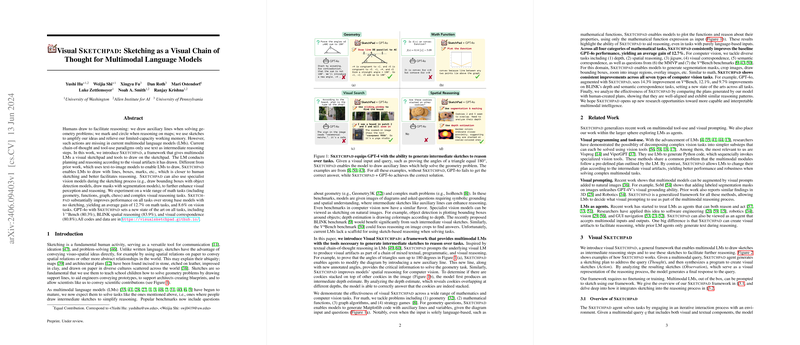Visual Sketchpad: Sketching as a Visual Chain of Thought for Multimodal LLMs
Overview
The paper "Visual Sketchpad: Sketching as a Visual Chain of Thought for Multimodal LLMs" introduces a novel framework named Sketchpad, which integrates visual sketching into the reasoning process of multimodal LLMs (LMs). The primary motivation behind this research is to enhance the cognitive capabilities of LMs by enabling them to incorporate visual sketches as intermediate steps, similar to how humans use auxiliary lines, diagrams, and notations in problem-solving. Sketchpad allows these models to draw on a virtual sketchpad using lines, boxes, and other marks, providing a more human-like approach to reasoning and planning in tasks that require visuo-spatial understanding.
Key Contributions
- Framework Design: Sketchpad provides a detailed mechanism for multimodal LMs to generate and utilize visual artifacts during the reasoning process. This is a significant departure from the traditional chain-of-thought frameworks that rely solely on text.
- Specialist Vision Models: The framework supports the integration of specialist vision models, such as object detection and segmentation models, to enhance the perception and reasoning abilities of the LMs.
- Wide Range of Tasks: The authors demonstrate the effectiveness of Sketchpad across diverse tasks, including mathematical problem-solving (geometry, functions, graph algorithms, and strategy games) and complex visual reasoning tasks from benchmarks like Bench, BLINK, and MMVP.
Numerical Results
The experimental results detailed in the paper highlight substantial performance improvements across a variety of benchmarks:
- On mathematical tasks, Sketchpad yields an average performance gain of 12.7% in math tasks and 8.6% in vision tasks over strong baseline models.
- Notably, GPT-4o integrated with Sketchpad sets new state-of-the-art results across all tested benchmarks, with specific improvements showcased as follows:
- Bench: 80.3%
- BLINK spatial reasoning: 83.9%
- Visual correspondence: 80.8%
Implications
Practical Implications:
The incorporation of visual sketching in multimodal LMs can significantly enhance the usability and application of such models in real-world scenarios. For instance, in education, LMs equipped with Sketchpad can aid in teaching complex mathematical concepts through visual demonstrations. In professional fields like engineering or architecture, these models can assist in visualizing solutions and planning more effectively.
Theoretical Implications:
From a theoretical perspective, the introduction of Sketchpad paves the way for more advanced multimodal intelligence systems. The ability to autonomously generate and adapt visual plans demonstrates a leap towards achieving more human-like problem-solving capabilities in artificial intelligence.
Future Directions
The development of Sketchpad opens several avenues for future research and development:
- Integration with Training Paradigms: Future models could be trained with native integration of Sketchpad-like functionality, potentially leading to even more significant improvements in performance and versatility.
- Expansion to Other Domains: Beyond mathematical and simple visual tasks, the principles of Sketchpad could be extended to more specialized domains such as medical imaging, robotics, and complex scientific computations.
- Enhanced Computational Efficiency: While the current implementation demonstrates substantial benefits, optimization techniques could be employed to reduce the computational overhead, making Sketchpad more practical for a wider range of applications.
Conclusion
The paper presents a compelling case for enhancing multimodal LLMs with visual sketching capabilities through the Sketchpad framework. By leveraging visual artifacts as part of the reasoning process, Sketchpad not only improves performance across a range of tasks but also aligns closer with human cognitive strategies. This research marks an important step towards creating more intuitive and powerful AI systems capable of addressing complex reasoning challenges in a holistic manner.
